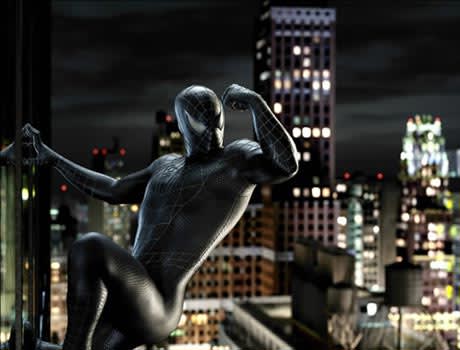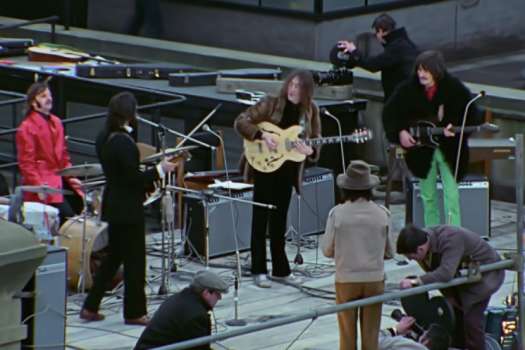Its been the biggest, the best and the most expensive, and at least for this early phase of summer, Spider-Man 3 is the most anticipated film of the year for good reason: director Sam Raimi has elevated a comic book film franchise into not just pop culture goodness but art. In the last two Spider-man films, Raimi showed a deft hand with action but more importantly, a deep understanding of character motivation and moral ambiguity. For his third act, Raimi has taken his successes and sped them up, putting more balls in the air and juggling harder and faster than he ever has before. But as this Spidey outing proves, more isnt always better.
As Spider-Man 3 begins, New York City and Mary Jane Watson (Kirsten Dunst) are both in love with Spider-Man and Peter Parker (Toby Maguire), respectively; not feeling the love is Parkers former best friend Harry Osborn (James Franco), whos vowed revenge on the superhero for the death of his father, the Green Goblin. Osborn takes up the Goblin mask to do battle with the webbed wonder in an intense and spectacular early fight sequence. Even more of Peters world unravels when faced with professional competition from up-and-coming photographer Eddie Brock (a delightfully playful Topher Grace) and from alien black goo that attaches itself to his Spidey suit as a parasite. Then he finds out that his beloved Uncle Bens killer remains at large turns out it wasnt that robber from the first film after all but a career criminal named Flint Marko, who gets atomised in a science experiment and turns into the shifting mass of the Sandman (one of this unbelievably expensive films most stunning effects).
To all of this, Parker reacts badly, giving into the black parasites influence and becoming more reckless in his pursuits of justice (or is that revenge)? He flirts with his science lab partner Gwen Stacey (a blonde Bryce Dallas Howard), fights with Mary Jane and teases the girl next door while revelling in his newfound celebrity. Meanwhile, Eddie Brock tries to steal his job then steals his powers when infected by the alien goo to become villain Venom.
With three primary villains, plus his own unravelling personal life, Spider-Man 3 carries Peter Parkers heaviest load, and though much of the film sparks with the life that Raimi has always brought to this franchise, it begins to weigh on the movie in its second half. Though he tries to bring some levity to the proceedings (in the much-discussed moment of fleet-footed dance: shark-jumping disaster or Raimi moment of Darkman insouciance?), theres simply too much packed into the film and its Peter Parker who eventually gets lost in the morass.
Its Raimis insistence on humanising his villains that eventually takes away from the good/evil axis thats key to such super-heroics; sure, he added a dose of humanity to Green Goblin and Doc Ock in the previous films but every villain here has a justified take on immorality: Flint Marko robs banks as the Sandman but only to save his dying daughter; Eddie Brock tries to strip everything from Peters life but only out of his own sense of insecurity (and is victimised by the Venom parasite); and Harry Osborn finally battles his daddy issues through high-flying combat.
Spidey himself has his ego inflated, then deflated, by Mary Jane; his dalliance with Gwen has more to do with fuelling Brocks rage; and he gets the snot beaten out of him in elaborate and expensive-looking ways. But what Spider-Man 3 doesnt do, which the first two films did so beautifully, is invest the viewer in Peter Parkers life struggles. Theres an abundance of high-flying zippideedooda but very little keeping this overstuffed effort grounded.
(Sony)As Spider-Man 3 begins, New York City and Mary Jane Watson (Kirsten Dunst) are both in love with Spider-Man and Peter Parker (Toby Maguire), respectively; not feeling the love is Parkers former best friend Harry Osborn (James Franco), whos vowed revenge on the superhero for the death of his father, the Green Goblin. Osborn takes up the Goblin mask to do battle with the webbed wonder in an intense and spectacular early fight sequence. Even more of Peters world unravels when faced with professional competition from up-and-coming photographer Eddie Brock (a delightfully playful Topher Grace) and from alien black goo that attaches itself to his Spidey suit as a parasite. Then he finds out that his beloved Uncle Bens killer remains at large turns out it wasnt that robber from the first film after all but a career criminal named Flint Marko, who gets atomised in a science experiment and turns into the shifting mass of the Sandman (one of this unbelievably expensive films most stunning effects).
To all of this, Parker reacts badly, giving into the black parasites influence and becoming more reckless in his pursuits of justice (or is that revenge)? He flirts with his science lab partner Gwen Stacey (a blonde Bryce Dallas Howard), fights with Mary Jane and teases the girl next door while revelling in his newfound celebrity. Meanwhile, Eddie Brock tries to steal his job then steals his powers when infected by the alien goo to become villain Venom.
With three primary villains, plus his own unravelling personal life, Spider-Man 3 carries Peter Parkers heaviest load, and though much of the film sparks with the life that Raimi has always brought to this franchise, it begins to weigh on the movie in its second half. Though he tries to bring some levity to the proceedings (in the much-discussed moment of fleet-footed dance: shark-jumping disaster or Raimi moment of Darkman insouciance?), theres simply too much packed into the film and its Peter Parker who eventually gets lost in the morass.
Its Raimis insistence on humanising his villains that eventually takes away from the good/evil axis thats key to such super-heroics; sure, he added a dose of humanity to Green Goblin and Doc Ock in the previous films but every villain here has a justified take on immorality: Flint Marko robs banks as the Sandman but only to save his dying daughter; Eddie Brock tries to strip everything from Peters life but only out of his own sense of insecurity (and is victimised by the Venom parasite); and Harry Osborn finally battles his daddy issues through high-flying combat.
Spidey himself has his ego inflated, then deflated, by Mary Jane; his dalliance with Gwen has more to do with fuelling Brocks rage; and he gets the snot beaten out of him in elaborate and expensive-looking ways. But what Spider-Man 3 doesnt do, which the first two films did so beautifully, is invest the viewer in Peter Parkers life struggles. Theres an abundance of high-flying zippideedooda but very little keeping this overstuffed effort grounded.




